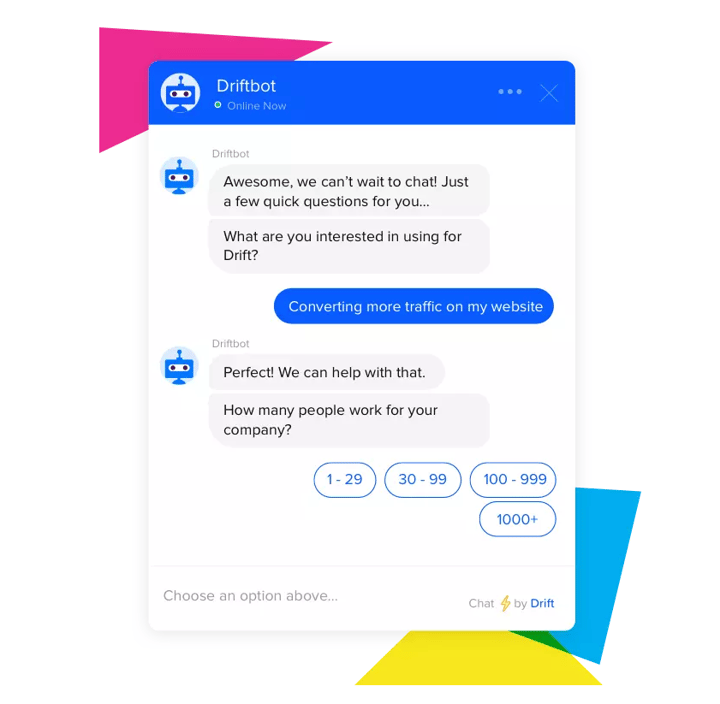
 Courtesy of Saturday Night Live
Courtesy of Saturday Night Live
This is the time of year every organization looks for ways to improve performance in the coming year. Everyone is evaluating what worked and what didn't in 2019, racing towards year-end goals, and building new goals. Sales forecasts and budgets are coming due. Everyone should be looking for new ideas to improve results.
So what can organizations do to help their sales team increase their performance in the coming year? Chatbots could help them book meetings faster and more efficiently. The chatbot could improve the bottom line in 2020, helping your sales team close more deals in less time. I'll show you how you can improve speed to lead, average days to close, and close percentage with the inclusion of chatbots.
What are chatbots, and how can they help sales?
To start, let's ask the all-knowing resource we've all come to lean on for definitions, Wikipedia.
A chatbot is a piece of software that conducts a conversation via auditory or textual methods. Such programs are often designed to convincingly simulate how a human would behave as a conversational partner, although as of 2019, they are far short of being able to pass the Turing test. Wikipedia
Thanks Wikipedia, home run. I've never thought of chatbots as replacements for humans. Let's try again, this time from another source:
A chatbot is an artificial intelligence (AI) program that simulates interactive human conversation by using key pre-calculated user phrases and auditory or text-based signals. ... A chatbot is also known as an artificial conversational entity (ACE), chat robot, talk bot, chatterbot or chatterbox. Techopedia
That's better. A chatbot is meant to simulate interactive conversation, not replace it. It's the start of a conversation. When built correctly, chatbots serve humans and ultimately help make a more meaningful human connection. Their job is to serve the visitor, help them find what they're looking for, harvest some valuable information about the visitor, and so on. Think of chatbots as additional conversion points on your website. They're like an auto-attendant that can direct website visitors towards information, resources, qualify for lead qualification, and even help people book a meeting without the need to fill out a web form and wait for someone to get back to them.
What technology should you add to build chatbots in?
Drift is the best software available to develop your chat playbooks with. As the first and only conversational marketing platform, Drift will help you generate more qualified leads without forms. Rather than forcing high intent prospects to jump through hoops to talk to your team, make it easy by qualifying your traffic in real-time. Drift can easily be configured to walk visitors through a series of questions to establish qualification parameters. This ensures sales personnel don't waste their time interacting with unqualified leads. Here's a simple example of how it looks:
As qualified leads work through the questions they're presented the ability to book a sales meeting on the spot. That's right, meetings are literally booked directly through the chatbot. This makes it must faster and easier for your prospects to get scheduled AND reduces the need for sales personnel to lift a finger. This reduces speed to lead and reduces the burden and effort by sales people to get meetings booked. Here's why we love Drift so much at Revenue River:
How to build a chatbot that will help sales hit their numbers
I asked Jason Levy, our in-house expert, to help me out. He works closely with the Drift team to architect the conversational marketing blueprint. His approach is straight forward, I think you'll like it.

By now most people are familiar with chatbots, having most likely interacted with them in their own personal experiences. But how to create chatbots to enable sales teams to reach their goals may still be a mystery. Allow me to demystify this a bit. A common misconception or use case of chatbots is the idea that as long as you have one built that can answer your most generic or frequently asked questions, then you're all set. This is counter-intuitive to why chatbots are incredibly effective... Personalization! By taking a "one size fits all" approach, many companies miss the mark on an incredible opportunity to create a memorable, personal experience that can make all the difference when a prospect is evaluating all their options.
Instead of this approach, try building a chatbot that answers the questions: Where, What, Who, and Why. Allow me to explain. First, understand Where a prospect is coming from to reach your site. Is it from a PPC campaign, a Facebook ad, an email campaign? Knowing this allows you to begin the conversation of your chatbot at a point that is relevant to the visitor. This also leads to deciding what page you should build the chatbot on. This is a more targeted approach. Sometimes it may be a landing page, other times it could be on a blog article you just promoted on LinkedIn.
In any case - again, it's attempting to extend a personal experience to your visitor. A great example may be to build a chatbot on a pricing page to a visitor that you recognize has been to your site once or twice before. At that point you could acknowledge that you understand their desire to investigate prices is a sign they are becoming more serious about the process. This could flag a sales person to log into the chatbot and begin a live conversation. Forget the entire scheduling process - let's talk right now!
Now that you know the Where and What, you must consider Who you are having this conversation with. Are they anonymous, a return visitor, a targeted account, or even an existing customer - in cases of customer service? For each of these types of visitors is another conversation. I'm sure you're starting to see the pattern here. By considering these questions, you are building a more customized, personal experience for the visitor. That's the beauty of chatbots. It offers you the ability to build a one-to-one conversation at scale.
Now you're also wondering, ok - but HOW do I 'Build' it to impact sales. This is the great part. You've established a personal experience with a prospect without lifting a finger. Ideally, the chatbot will request some qualifying information in the flow of the conversation. With a lead that has passed the necessary qualifiers, it becomes more likely the prospect is open to agreeing to your end-goal, whether that's scheduling a Demo, having a more in-depth call, or even asking to speak to a human at that moment. Now that's what we're talking about "speed to lead".
If built correctly, answering questions about When, What, Who, and Why sets up the bot to speak to the right person at the right time about the right subject. After this magic has happened, and the lead feels you understand their pain-point, they are more likely to reach your goal. If that goal is scheduling a Demo, and you offer them your calendar - Bingo. You've just booked another golden opportunity to do what you do best... Sell!
For a few more tips on bots and conversational marketing, this conversation is worth a listen:

Put it all together, and drive more sales!
Success stories can really help people put together the potential with digital services like chat bots and conversational marketing. Centage has a great story of how they rolled out chatbots with a limited initial bot. Here's Kory Wagner talking about their process.
Our implementation of Drift started out pretty small with just a single bot that functioned mostly as an away message after hours. But once we opened it up and started using it to have actual conversations, we really saw the potential. Though we initially only rolled it out to a few members of our BDR team, it didn’t take long for the rest of the team to see how it was working.
It all snowballed from there, and now the entire team is on it and loving both the process and the results. Not only are we able to provide our account execs with much warmer conversations, we’re also routinely shortening the sales cycle by as much as 85 percent. Kory Wagner
Put a chatbot to work for your business in 1 day
You can get a chatbot off the ground and working for your business in no time. At Revenue River we're experts in empowering sales teams. We're also a Drift agency partner. We can get you into the right license package and build your strategy. We'll get your first chatbot live in 1 day, and go from there.
If you're interested, here's a great resource: Jason's article on building a conversational growth strategy is a must read.
We also have an easy-to-use conversational blueprint free for download. You can build your targeting strategy before you start building your first bot. It will help you connect with your ideal buyer and improve those conversations and conversions. If you're interested, check out our chatbot on this page. We'll get you a copy.
If your mind is on 2020 growth strategies, our friends at Venngage build a really nice growth strategy checklist. Give it a read, it might help with your strategy and planning.

